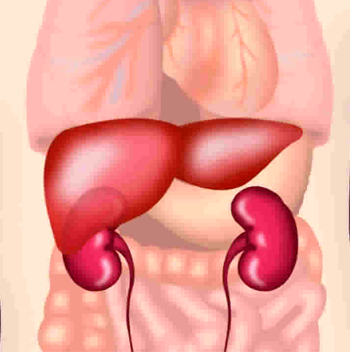BACKGROUND
As the term suggests, the word «hepato» pertains to the liver, while «renal» refers to the kidney. Hence, hepatorenal syndrome implies a condition where liver disease leads to kidney disease or in extreme cases, complete kidney failure. Estimates indicate that at least 40% of patients with cirrhosis and ascites will develop HRS during the natural history of their disease.
DISEASE OCCURRENCE IN POPULATION
Hepatorenal syndrome (HRS) is common, with a reported incidence of 10% among hospitalized patients with cirrhosis and ascites.In decompensated cirrhotics, the probability of developing HRS with ascites ranges between 8-20% per year and increases to 40% at 5 years. An estimated 35-40% of patients with end-stage liver disease (ESLD) and ascites will develop HRS.
According to the study conducted in Pakistan, 15.09% of patients with cirrhosis were found to have HRS. Another study found the frequency of hepatorenal syndrome was 19.9% in liver cirrhotic patients.

RISK FACTORS
The initiating factor in hepatorenal syndrome is always some kind of liver disease. This could be everything ranging from hepatitis (from viruses like Hepatitis B or C, drugs, autoimmune disease, etc.), to tumors in the liver, to cirrhosis, or even the most dreaded form of liver disease associated with rapid decline in liver function, called fulminant liver failure. All of these conditions can induce kidney disease and kidney failure of varying levels of severity in the hepatorenal patient.
However, there are some clearly identified and specific risk factors that significantly increase the chances of someone developing kidney failure because of liver disease.
- Infection of the abdominal cavity (which can sometimes happen in people with cirrhosis), called spontaneous bacterial peritonitis (SBP)
- Bleeding into the gut, which is common in cirrhosis patients from blood vessels that bulge into the esophagus for instance (esophageal varices)
- Water pills (diuretics like furosemide or spironolactone) that are given to patients with cirrhosis and fluid overload do not precipitate hepatorenal syndrome (although they can hurt the kidneys in other ways).
- Previous episodes of ascites
- Presence of esophageal varices
- Poor nutritional status
SIGN AND SYMPTOMS
Hepatorenal syndrome (HRS) has no specific signs.
The hands may exhibit the following:
- Palmar erythema
- Leuconychia
- Asterixis
- Muscle wasting
- Clubbing
- Head, ears, nose, throat examination may reveal the following:
- Muscle wasting
- Fetor hepaticus
- Chest findings may include gynecomastia/ male breasts.
- The genitalia may show loss of pubic hair/secondary sexual characteristics in men and/or atrophic testes.
DIAGNOSTIC TESTS
Laboratory investigations includes:
- Complete blood cell count
- Serum electrolytes and renal function test
- Liver function tests
- Prothrombin time
- Alpha-fetoprotein levels
Blood cultures
Cryoglobulins
Urinalysis and urine electrolytes
Abdominal ultrasonography
Echocardiography
TREATMENT OPTIONS
The ideal treatment of HRS is liver transplantation; however, because of the long waiting lists in the majority of transplant centers, most patients die before transplantation.
Here are a few choices that we have:
- In recent years, there has been some good evidence about the role of a new medication called terlipressin. Its use is recommended in most of the world for hepatorenal syndrome treatment. Other medication may be used such as norepinephrine (a common medication used in the ICU to raise blood pressure in people with excessively low blood pressure from shock), as well as a «cocktail regimen» that involves 3 drugs, called octreotide, midodrine and albumin (the major protein present in blood).
- If these medications don’t work, an interventional procedure called TIPS (transjugular intrahepatic portosystemic shunt) placement might be beneficial, although that comes with its own set of problems.
- Finally, if everything fails and the kidneys do not recover, dialysis might be necessary as a «bridge therapy» until the liver disease can be addressed definitively.
Typically, if medications described above do not work within two weeks, treatment might be considered futile and the risk of death goes up drastically.
PRECAUTIONS
Patients who have cirrhosis with ascites must be informed that they are at risk of developing HRS and they must be informed about the dismal prognosis this carries in the absence of liver transplantation. They should be very cautious when new medications are prescribed by physicians not familiar with their care and must avoid known nephrotoxic agents such as nonsteroidals and aminoglycosides. Any deterioration in their clinical condition should result in a prompt call to their physician to determine if they have developed HRS.
REFERENCES
- https://www.verywellhealth.com/diagnosis-and-treatment-of-hepatorenal-syndrome-4082880
- Bittencourt PL, de Carvalho GC, de Andrade Regis C, Kalil JR, Cerqueira LA, Barbosa DS, et al. Causes of renal failure in patients with decompensated cirrhosis and its impact in hospital mortality. Ann Hepatol. 2012 Jan. 11(1):90-5.
- Al-Khafaji A, Nadim MK, Kellum JA. Hepatorenal Disorders. Chest. 2015 Aug. 148 (2):550-8.
- Seetlani NK, Memon AR, Iftikhar F, Ali A, Fazel PA. Hepatorenal syndrome in patients with cirrhosis of liver according to 2007 international ascites club criteria. Journal of Ayub Medical College Abbottabad. 2016 Aug 24;28(3):578-81.
Ullah I, Ziauddin MB, Mahmood K. FREQUENCY OF HEPATORENAL SYNDROME IN PATIENTS WITH LIVER CIRRHOSIS. KJMS. 2016 May;9(2):252.
